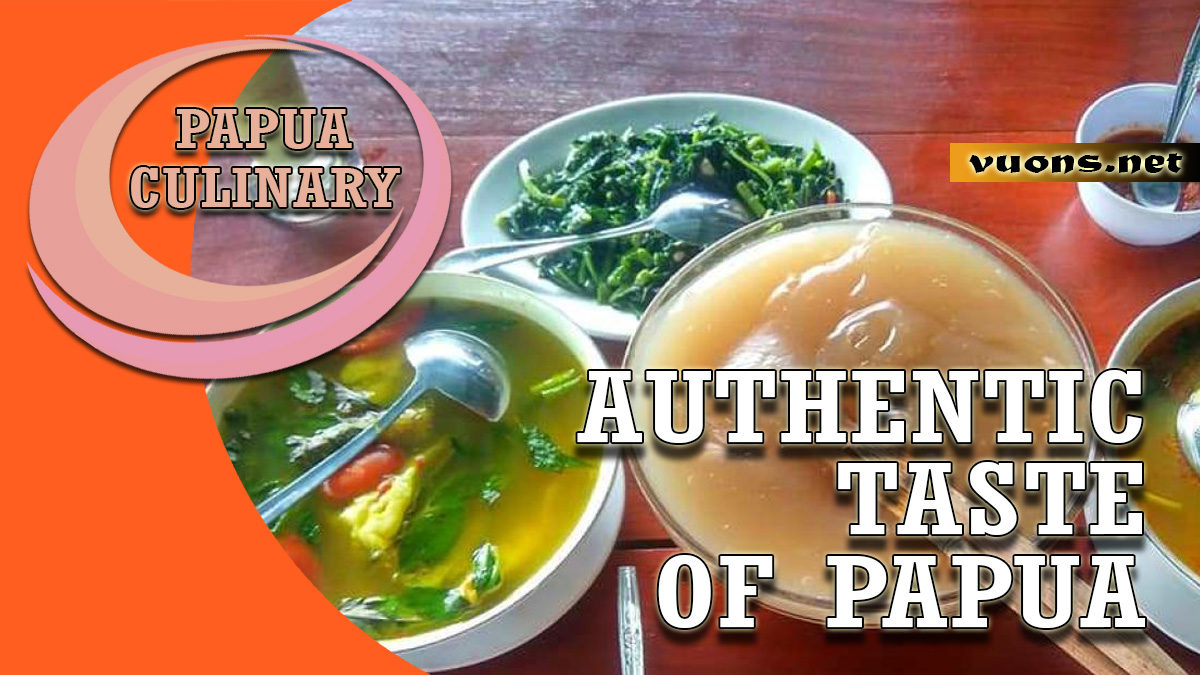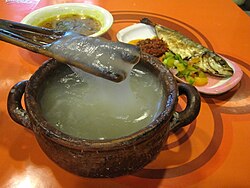EXPLORING AUTHENTIC FLAVOR OF PAPUA THROUGH PAPEDA
Brief History of Papeda: From Sago to Becoming a Staple Food
Papeda is a staple food that is very typical of the Papua and Maluku regions in Indonesia. This dish is not only appetizing with its unique texture, but also holds long stories and traditions that are important to the local community. A Brief History of Papeda: From Sago to Staple Food provides an overview of the origins and culinary journey that brought papeda into the daily lives of Papuans.
A Brief History of Papeda: From Sago to Becoming a Staple Food
Papeda comes from the sago tree, which grows abundantly in swampy and tropical areas in Papua and Maluku. Since ancient times, local people have used sago as the main source of carbohydrates. The process of making papeda begins by cutting down a sago tree, taking the stem, and then grating the inside of the stem to get sago flour. This sago flour is then filtered and allowed to settle before being cooked in hot water until it becomes papeda.
Initially, papeda was consumed as daily food by local residents because of the abundant availability of raw materials and the relatively simple manufacturing process. However, over time, papeda has also become an integral part of various traditional ceremonies and traditions, making it more than just a staple food, but also a symbol of the culture and identity of the people of Papua and Maluku.
Texture and Taste: What Makes Papeda So Unique?
Papeda has a sticky and thick texture, similar to glue, which differentiates it from other staple foods such as rice or bread. The taste itself tends to be neutral, so it is often served with various side dishes that are rich in herbs and spices, such as fish in yellow sauce or vegetables. This combination creates a rich and satisfying harmony of flavors.
Papeda in Papuan Culture: Meaning and Tradition
Apart from being an everyday food, papeda also has deep cultural meaning. In various traditional ceremonies, papeda is often presented as a symbol of unity and togetherness. The process of cooking and eating papeda together is an important moment to strengthen family and community relationships.
Nutrition and Health Benefits of Papeda
Papeda is rich in carbohydrates, but low in fat and protein. However, because it is often served with fish and vegetables, this dish remains a source of balanced nutrition. Additionally, sago is also known to be gluten-free, making it a good choice for those with gluten intolerance.
Papeda in Modern Culinary: Innovation Without Losing Authenticity
In modern times, papeda is starting to become more widely known outside Papua and Maluku. Several restaurants in big Indonesian cities have even started serving papeda with more modern variations, without losing the authenticity and tradition attached to it. This innovation helps promote papeda as an important part of Indonesia’s culinary heritage that is worth preserving.
Papeda is real proof of how traditional food can survive and continue to develop amidst changing times. With its unique texture and taste, as well as deep cultural values, papeda remains one of the alluring culinary icons of Papua and Maluku. Through this dish, we can explore and experience the authenticity and extraordinary richness of Papuan culture.
Texture and Taste: What Makes Papeda So Unique
With a long history and deep cultural value, papeda is not only a source of food, but also a symbol of identity for the local community. Texture and Taste: What Makes Papeda So Unique will take a deeper look at the extraordinary characteristics of papeda.
A Brief History of Papeda: From Sago to Becoming a Staple Food
Papeda is made from sago flour, which is taken from the trunk of the sago tree. Since ancient times, the people of Papua and Maluku have processed sago into papeda through a process that involves grating the sago stems, filtering, settling, and finally cooking it in hot water to produce thick, sticky papeda. Initially, papeda was an everyday food that was easy to make and was the main source of carbohydrates for the local community.
Texture and Taste: What Makes Papeda So Unique
Papeda has a very distinctive texture and is different from other staple foods. Texture and Taste: What Makes Papeda So Unique is its viscosity and stickiness, which resembles glue. When cooked, sago turns into a thick, transparent mass that is difficult to separate. The cooking process requires constant stirring until it reaches the right consistency.
The taste of papeda itself tends to be neutral, allowing it to be the perfect accompaniment to side dishes that have strong flavors and rich spices. Side dishes such as fish in yellow sauce, seasoned with turmeric and other spices, go very well with papeda. This combination creates a harmony of flavors that pampers the tongue and satisfies the palate.
Papeda in Papuan Culture: Meaning and Tradition
Apart from being a daily food, papeda has an important role in various traditional ceremonies in Papua and Maluku. In a cultural context, papeda is often presented as a symbol of togetherness and unity. The event of eating papeda together is a moment to strengthen family and community relationships, reflecting strong social values in society.
Nutrition and Health Benefits of Papeda
Papeda is a good source of carbohydrates, but low in fat and protein. When served with protein-rich side dishes such as fish and vegetables, papeda becomes a balanced and nutritious dish. In addition, sago flour is gluten-free making papeda a safe choice for those who have gluten intolerance.
Papeda in Modern Culinary: Innovation Without Losing Authenticity
In recent years, papeda has begun to become more widely known outside Papua and Maluku. Several modern restaurants in Indonesia serve papeda with creative variations, but still maintain the authenticity and traditions. This innovation not only introduces papeda to a wider audience but also preserves this valuable culinary heritage.
Papeda is proof of how traditional food can survive and continue to be appreciated amidst modernization. With its unique texture and taste, as well as rich cultural value, papeda remains an alluring culinary icon from Papua and Maluku. Through papeda, we can experience the extraordinary authenticity and richness of Papuan culture.
Papeda in the Eyes of the World: How This Traditional Food Gains Global Recognition
Papeda in the Eyes of the World: How This Traditional Food Gained Global Recognition will examine how papeda, despite its origins in remote areas of Indonesia, has managed to penetrate cultural boundaries and attract international interest.
A Brief History of Papeda: From Sago to Becoming a Staple Food
Papeda is made from sago flour, which is produced from the trunk of the sago tree. The manufacturing process involves grating, filtering, and cooking with hot water to produce a thick and sticky texture. Initially, papeda was a staple food eaten daily by the people of Papua and Maluku, but as time went by, the cultural values and unique taste of papeda began to attract attention outside Indonesia.
Papeda in the Eyes of the World
Global recognition of papeda is not only limited to its unique taste and texture, but also because of the cultural value stored in it. This traditional food has been able to penetrate the international market thanks to promotional efforts from the Indonesian government and global interest in authentic, exotic food.
The Unique Texture and Taste of Papeda
One of the main factors that makes papeda popular internationally is its thick and sticky texture, similar to glue, as well as its neutral taste which makes it suitable for combining with various traditional side dishes such as fish in yellow sauce or grilled meat. This combination creates a unique and satisfying culinary experience.
Papeda in a Modern Culinary Context
In recent years, papeda has begun to appear on the menus of luxury restaurants in various countries, which present this dish with a modern twist but still maintain its authenticity and traditional taste. This is proof of how papeda has not only survived as a traditional food, but has also developed and been accepted in a global culinary context.




